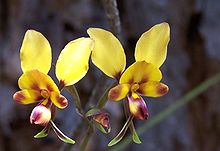Diuris
| Donkey orchids | |
|---|---|
 |
|
| Diuris carinata | |
| Scientific classification | |
| Kingdom: | Plantae |
| (unranked): | Angiosperms |
| (unranked): | Monocots |
| Order: | Asparagales |
| Family: | Orchidaceae |
| Subfamily: | Orchidoideae |
| Tribe: | Diurideae |
| Subtribe: | Diuridinae |
| Genus: |
Diuris Sm., 1798 |
Diuris, commonly known as donkey orchids, is a genus of more than sixty species of flowering plants in the orchid family, Orchidaceae and is endemic to Australia apart from one species endemic to Timor. The name "Diuris" refers to the hanging sepals but the common name derives from the ear-like petals common to all species. All have mainly yellow flowers with darker markings and are thought to mimic nectar-producing flowers which open at the same time.
Orchids in the genus Diuris are terrestrial, perennial, deciduous, sympodial herbs, usually with a few inconspicuous, fine roots and one or two tubers lacking a protective sheath. The stem is short, erect and unbranched with a leaf-like cataphyll at each node. There are between one and ten grass-like leaves at the base of the plant.
The inflorescence is a raceme with a few to many brightly coloured, resupinate flowers on a wiry stalk. The sepal is shorter but wider than two sepals and forms a hood over the column. The long, narrow, lateral sepals hang like a pair of tails below the labellum. The petals are different from the sepals, having a narrow base with the main part widely expanded, in the form of donkey ears. As is usual in orchids, one petal is highly modified as the central labellum, differing markedly from the other petals and sepals. The labellum has three distinct parts with the central part folded and the lateral parts arranged on either side of the column, often spreading widely, sometimes with a or wavy edge. The column is short with narrow wings. Flowering time depends on species but most species flower between September and November. One of the earliest to flower, D. brumalis flowers in June and D. emarginata sometimes flowers as late as January. The fruit which follows flowering is a thin-walled, dehiscent capsule containing up to 100 winged seeds.
...
Wikipedia
